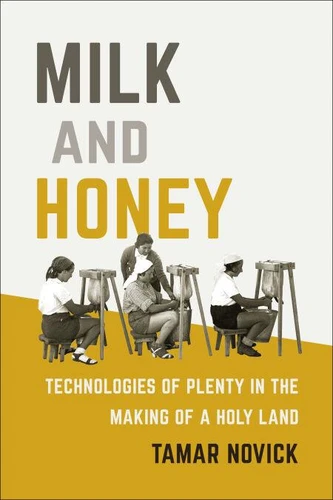Milk and Honey. Technologies of Plenty in the Making of a Holy Land
Par :Formats :
Disponible dans votre compte client Decitre ou Furet du Nord dès validation de votre commande. Le format ePub protégé est :
- Compatible avec une lecture sur My Vivlio (smartphone, tablette, ordinateur)
- Compatible avec une lecture sur liseuses Vivlio
- Pour les liseuses autres que Vivlio, vous devez utiliser le logiciel Adobe Digital Edition. Non compatible avec la lecture sur les liseuses Kindle, Remarkable et Sony
- Non compatible avec un achat hors France métropolitaine
 , qui est-ce ?
, qui est-ce ?Notre partenaire de plateforme de lecture numérique où vous retrouverez l'ensemble de vos ebooks gratuitement
Pour en savoir plus sur nos ebooks, consultez notre aide en ligne ici
- Nombre de pages278
- FormatePub
- ISBN978-0-262-37456-9
- EAN9780262374569
- Date de parution11/07/2023
- Protection num.Adobe DRM
- Taille4 Mo
- Infos supplémentairesepub
- ÉditeurThe MIT Press
Résumé
An innovative historical analysis of the intersection of religion and technology in making the modern state, focusing on bodily production and reproduction across the human-animal divide. In Milk and Honey, Tamar Novick writes a revolutionary environmental history of the state that centers on the intersection of technology and religion in modern Israel/Palestine. Focusing on animals and the management of their production and reproduction across three political regimes-the late-Ottoman rule, British rule, and the early Israeli state-Novick draws attention to the ways in which settlers and state experts used agricultural technology to recreate a biblical idea of past plenitude, literally a "land flowing with milk and honey, " through the bodies of animals and people. Novick presents a series of case studies involving the management of water buffalo, bees, goats, sheep, cows, and peoplein Palestine/Israel.
She traces the intimate forms of knowledge and bodily labor-production and reproduction-in which this process took place, and the intertwining of bodily, political, and environmental realms in the transformation of Palestine/Israel. Her wide-ranging approach shows technology never replaced religion as a colonial device. Rather, it merged with settler-colonial aspirations to salvage the land, bolstering the effort to seize control over territory and people.
Fusing technology, religious fervor, bodily labor, and political ecology, Milk and Honey provides a novel account of the practices that defined and continue to shape settler-colonialism in the Palestine/Israel, revealing the ongoing entanglement of technoscience and religion in our time.
She traces the intimate forms of knowledge and bodily labor-production and reproduction-in which this process took place, and the intertwining of bodily, political, and environmental realms in the transformation of Palestine/Israel. Her wide-ranging approach shows technology never replaced religion as a colonial device. Rather, it merged with settler-colonial aspirations to salvage the land, bolstering the effort to seize control over territory and people.
Fusing technology, religious fervor, bodily labor, and political ecology, Milk and Honey provides a novel account of the practices that defined and continue to shape settler-colonialism in the Palestine/Israel, revealing the ongoing entanglement of technoscience and religion in our time.
An innovative historical analysis of the intersection of religion and technology in making the modern state, focusing on bodily production and reproduction across the human-animal divide. In Milk and Honey, Tamar Novick writes a revolutionary environmental history of the state that centers on the intersection of technology and religion in modern Israel/Palestine. Focusing on animals and the management of their production and reproduction across three political regimes-the late-Ottoman rule, British rule, and the early Israeli state-Novick draws attention to the ways in which settlers and state experts used agricultural technology to recreate a biblical idea of past plenitude, literally a "land flowing with milk and honey, " through the bodies of animals and people. Novick presents a series of case studies involving the management of water buffalo, bees, goats, sheep, cows, and peoplein Palestine/Israel.
She traces the intimate forms of knowledge and bodily labor-production and reproduction-in which this process took place, and the intertwining of bodily, political, and environmental realms in the transformation of Palestine/Israel. Her wide-ranging approach shows technology never replaced religion as a colonial device. Rather, it merged with settler-colonial aspirations to salvage the land, bolstering the effort to seize control over territory and people.
Fusing technology, religious fervor, bodily labor, and political ecology, Milk and Honey provides a novel account of the practices that defined and continue to shape settler-colonialism in the Palestine/Israel, revealing the ongoing entanglement of technoscience and religion in our time.
She traces the intimate forms of knowledge and bodily labor-production and reproduction-in which this process took place, and the intertwining of bodily, political, and environmental realms in the transformation of Palestine/Israel. Her wide-ranging approach shows technology never replaced religion as a colonial device. Rather, it merged with settler-colonial aspirations to salvage the land, bolstering the effort to seize control over territory and people.
Fusing technology, religious fervor, bodily labor, and political ecology, Milk and Honey provides a novel account of the practices that defined and continue to shape settler-colonialism in the Palestine/Israel, revealing the ongoing entanglement of technoscience and religion in our time.



